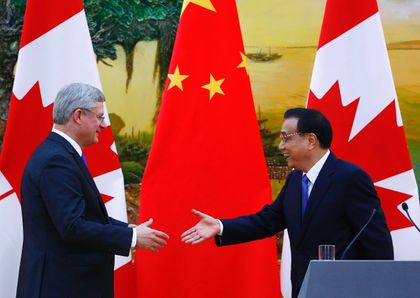Related Articles
The march of global de-dollarization continues.
In the last few days, China has signed direct currency agreements with Canada becoming North America’s first offshore RMB hub, which CBC reports analysts suggest “could double maybe even triple the level of Canadian trade between Canada and China,” impacting the need for Dollars.But that is not the week’s biggest Petrodollar precariousness news, as The Examiner reports, a new chink in the petrodollar system was forged as China signed an agreement with Qatar to begin direct currency swaps between the two nations using the Yuan, and establishing the foundation for new direct trade with the OPEC nation in the very heart of the petrodollar system. As Simon Black warns, ”It’s happening… with increasing speed and frequency.”
As CBC reports,

Authorized by China’s central bank, the deal will allow direct business between the Canadian dollar and the Chinese yuan, cutting out the middle man — in most cases, the U.S. dollar. Canadian exporters forced to use the American currency to do business in China are faced with higher currency exchange costs and longer waits to close deals. “It’s something the prime minister has been talking about. He wants Canadian companies, particularly small- and medium-sized businesses, doing more and more work in China, selling goods and services there,” said CBC’s Catherine Cullen, reporting from Beijing.Sovereign Man’s Simon Black has some ominous thoughts on Canada’s move…
It’s happening. With increasing speed and frequency. The People’s Bank of China and the Canadian Prime Minister’s office issued a statement on Saturday stating that Canada will establish North America’s first offshore renminbi trading center in Toronto. China and Canada agreed on a number of measures to increase the use of renminbi in trade, business, and investment. And they further signed a 200-billion renminbi bilateral currency swap agreement. Moreover, just today, hot off the presses, the central banks of China and Malaysia announced the establishment of renminbi clearing arrangements in Kuala Lumpur, which will further increase the use of renminbi in South-East Asia. This comes just two weeks after Asia’s leading financial center, Singapore, became a major renminbi hub, with direct convertibility established between the Singapore dollar and the renminbi.And as Black notes, everyone is in on the trend. All across the world, the renminbi is quickly becoming THE currency for trade, investment, and even savings.
Renminbi deposits in South Korea, for example, surged 55-times in one single year. It’s stunning. The government of UK just issued a renminbi bond, becoming the first foreign government to issue debt in renminbi. Even the European Central bank is debating to include renminbi in its official reserves, while politicians the world over are sounding not-so-subtle warnings that a new non-dollar monetary system is needed. Nothing goes up or down in a straight line. And given how volatile Europe and the global economy continue to be, the dollar may certainly be in for its surges and bumps in the coming months. But over the long-term it’s glaringly obvious where this trend is going: the rest of the world no longer wants to rely on the US dollar, and they’re making it a reality whether the US likes it or not.* * * And now, no lesser oil-producing state than controversial Qatar has signed an agreement too.. seemingly opening up the door to Petrodollar panic… (as The Examiner reports)
The petro-dollar system is the heart and soul of America’s domination over the global reserve currency, and their right to make all nations have to purchase U.S. dollars to be able to buy oil in the open market. Bound through an agreement with Saudi Arabia and OPEC in 1973, this de facto standard has lasted for over 41 years and has been the driving force behind America’s economic, political, and military power. But on Nov. 3 a new chink in the petro-dollar system was forged as China signed an agreement with Qatar to begin direct currency swaps between the two nations using the Yuan, and establishing the foundation for new direct trade with the OPEC nation in the very heart of the petro-dollar system. While this new agreement between China and Qatar is only for the equivalent of $5.7 billion over the next three years, Qatar becomes the 24th nation to open its Forex market to the Chinese currency, and solidifies acceptance of the Yuan as a viable option for the future in the Middle East. China’s central bank announced Monday that it has signed a currency swap deal worth 35 billion yuan (about 5.7 billion US dollars) with the central bank of Qatar. The three-year deal could be extended upon agreement by the two sides,said a statement on the website of the People’s Bank of China (PBOC). Also on Monday, the two sides signed a memorandum of understanding on Renminbi clearing settlement in Doha. China agreed to extend the RMB Qualified Foreign Institutional Investor scheme to Qatar, with an initial quota of 30 billion yuan. The deal marked a new step forward in financial cooperation between the two countries, and will facilitate bilateral trade and investment to help maintain regional financial stability, the statement said. - China Daily It is perhaps no coincidence that the term for the new agreement is set for three years, and is within the exact time frame being predicted by the director of the Finance Institute under the Development Research Center of the State Council, Zhang Chenghui for the Renminbi to become fully convertible in the global financial system. The need for new markets and a more stable trade currency in Qatar could be tied to a new report issued last week by French bank BNP Paribas which showed that petro-dollar recycling has fallen to its lowest levels in 18 years, signifying that even oil producing nations in the Middle East are finding it difficult to trust the U.S. dollar, and facilitate its use in trade due to its depreciation since the advent of the Federal Reserve’s massive QE programs. Nearly every week now, China, Russia, or one of the BRICS nations are finalizing agreements that supersede the old system of dollar trade and reliance on the petro-dollar system. And as many countries begin to reject the dollar due to the exported inflation that is growing in nations that are relegated to having to hold them for global oil purchases, alternatives such as the Chinese Yuan will become a more viable option, especially now that the Asian power has taken over the top spot as the world’s biggest economy.* * * The demise of Petrdollar flows…

 The Arab Democrat The Latest From The Arab World
The Arab Democrat The Latest From The Arab World






